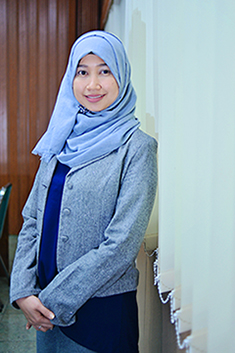Optimization Using D-Optimal Design of Nanostructured Lipid Carrier (NLC) with Variation of Surfactants and Co-surfactant
Downloads
Background: Nanostructured lipid carriers (NLC) are topical delivery systems designed to address the challenges associated with active ingredients, such as poor solubility and limited skin penetration. NLCs incorporate surfactants, such as sorbitan monooleate and lauryl glucoside, to stabilize the system, while the addition of soy lecithin as a co-surfactant further enhances NLC stability. A D-optimal design was employed to optimize the NLC components, ensuring that the formulation achieved the desired characteristics. Objective: To determine the optimal NLC formulation. Method: Optimization was conducted using the D-optimal design method. The NLCs were prepared using the high-shear homogenization method with an Ultra-Turrax device. Characterization included measuring the particle size, polydispersity index (PDI), pH, and creaming index. Results: All formulations resulted in homogeneous emulsions with a white color, slight aroma of castor oil, smooth texture, and thick consistency. The particle sizes ranged from 200 to 500 nm, although the polydispersity index was not significantly influenced by surfactants or co-surfactants. All the formulations maintained an appropriate pH range for skin compatibility and product stability. The %creaming index demonstrated that the co-surfactant effectively reduced creaming in the NLCs. Conclusion: The optimal formulation consisted of 0.284% sorbitan monooleate, 3.429% lauryl glucoside, and 0.287% soy lecithin.
Amasya, G., Aksu, B., Badilli, U., Onay-Besikci, A. & Tarimci, N., (2019). Qbd Guided Early Pharmaceutical Development Study: Production of Lipid Nanoparticles by High Pressure Homogenization for Skin Cancer Treatment. International Journal of Pharmaceutics; 563; 110-121. doi: 10.1016/j.ijpharm.2019.03.056.
Annisa, R., Mutiah, R., Yuwono, M. & Hendradi, E. (2022). The Development Formulation of Eleutherine palmifolia Extract-Loaded Self-Nanoemulsifying Drug Delivery System (SNEDDS) using D-Optimal Mixture Design Approach. International Journal of Applied Pharmaceutics; 15; 1-8. doi: 10.22159/ijap.2023v15i5.47645.
Apostolou, M., Assi, S., Fatokun, A.A. & Khan, I., (2021). The Effects of Solid and Liquid Lipids on the Physicochemical Properties of Nanostructured Lipid Carriers. Journal of Pharmaceutical Sciences; 110; 2859-2872. doi: 10.1016/j.xphs.2021.04.012.
Azzahrah, R., Rosita, N., Purwanto, D.A. & Soeratri, W. (2022). The Effect of Decyl Glucoside on Stability and Irritability of Nanostructured Lipid Carriers-Green Tea Extract as Topical Preparations. Pharmacy & Pharmaceutical Sciences Journal/Jurnal Farmasi Dan Ilmu Kefarmasian Indonesia; 9; 220-228. doi: 10.20473/jfiki.v9i32022.220-228.
Bhoyrul, B., Solman, L., Kirk, S., Orton, D. & Wilkinson, M. (2019). Patch Testing with Alkyl Glucosides: Concomitant Reactions are Common but not Ubiquitous. Contact Dermatitis; 80(5); 286-290. doi: 10.1111/cod.13186.
Das, R., Mallik, N., Adhikari, A. & Bhattarai, A. (2024). A Comprehensive Review on the Creation, Description, and Utilization of Surfactants Containing Multiple Hydroxyl Groups. International Journal of Polymer Science; 2024; 1-31. doi: 10.1155/2024/6120535.
Garcia, N.O., Fernandes, C.P. & da Conceição, E.C. (2019). Is it Possible to Obtain Nanodispersions with Jaboticaba Peel’s Extract Using Low Energy Methods and Absence of Any High Cost Equipment? Food Chemistry; 276; 475-484. doi: 10.1016/j.foodchem.2018.10.037.
Ghasemiyeh, P., Azadi, A., Daneshamouz, S., Heidari, R., Azarpira, N. & Mohammadi-Samani, S. (2019). Cyproterone Acetate-Loaded Nanostructured Lipid Carriers: Effect of Particle Size on Skin Penetration and Follicular Targeting. Pharmaceutical Development and Technology; 24; 812-823. doi: 10.1080/10837450.2019.1596133.
Haji, M., Hosseinzadeh, M., Jahangiri, Y., Farajzadeh, Z., Sufiani, A.M., Olyaei, Y.A., Namarvar, B.B., Ghaffari, T. & Olyaei, N.A. (2023). Ghee Based Nanostructured Lipid Carriers (Nlcs) with Improved Wound-Healing Effects: Ghee Based Nanostructured Lipid Carriers (Nlcs). Iranian Journal of Pharmaceutical Sciences; 19; 293-303. doi: 10.22037/ijps.v19i4.42194.
Hoseini, B., Jaafari, M.R., Golabpour, A., Momtazi-Borojeni, A.A., Karimi, M. & Eslami, S. (2023). Application of Ensemble Machine Learning Approach to Assess the Factors Affecting Size and Polydispersity Index of Liposomal Nanoparticles. Scientific Reports; 13; 1-11. doi: 10.1038/s41598-023-43689-4.
Jafar, G., Salsabilla, S. & Santoso, R. (2022). Development and Characterization of Compritol Ato® Base in Nanostructured Lipid Carriers Formulation with the Probe Sonication Method. International Journal of Applied Pharmaceutics; 14; 64-66. doi: 10.22159/ijap.2022.v14s4.PP04.
Javed, S., Mangla, B., Almoshari, Y., Sultan, M.H. & Ahsan, W. (2022). Nanostructured Lipid Carrier System: A Compendium of Their Formulation Development Approaches, Optimization Strategies by Quality by Design, and Recent Applications in Drug Delivery. Nanotechnology Reviews; 11; 1744-1777. doi: 10.1515/ntrev-2022-0109.
Lechuga, M., Avila-Sierra, A., Lobato-Guarnido, I., García-López, A.I., Ríos, F. & Fernández-Serrano, M. (2023). Mitigating the Skin Irritation Potential of Mixtures of Anionic and Non-Ionic Surfactants by Incorporating Low-Toxicity Silica Nanoparticles. Journal of Molecular Liquids; 383; 1-10. doi: 10.1016/j.molliq.2023.122021.
Loi, C.C., Eyres, G.T. & Birch, E.J. (2019). Effect of Mono-and Diglycerides on Physical Properties and Stability of a Protein-Stabilised Oil-In-Water Emulsion. Journal of Food Engineering; 240; 56-64. doi: 10.1016/j.jfoodeng.2018.07.016.
Mayangsari, F.D., Erawati, T., Soeratri, W. & Rosita, N. (2021). Karakteristik dan Stabilitas Fisik NLC-Koenzim Q10 dalam Sleeping Mask dengan Minyak Nilam. Jurnal Farmasi Dan Ilmu Kefarmasian Indonesia; 8; 178-186. doi: 10.20473/jfiki.v8i22021.178-186.
Mohammadi, M., Assadpour, E. & Jafari, S.M. (2019). Encapsulation of Food Ingredients by Nanostructured Lipid Carriers (Nlcs). in Jafari, S.M. (Ed.). Lipid-based Nanostructures for Food Encapsulation Purposes. Academic Press; 2; 217-270 doi: 10.1016/B978-0-12-815673-5.00007-6.
Moulik, S.P., Rakshit, A.K. & Naskar, B. (2024). Physical Chemical Properties of Surfactants in Solution and Their Applications: A Comprehensive Account. Journal of Surfactants and Detergents; 27; 895-925. doi: 10.1002/jsde.12757.
Nazarova, A., Yakimova, L., Filimonova, D. & Stoikov, I. (2022). Surfactant Effect on the Physicochemical Characteristics of Solid Lipid Nanoparticles Based on Pillar [5] Arenes. International Journal of Molecular Sciences; 23; 1-14. doi: 10.3390/ijms23020779.
Nollet, M., Boulghobra, H., Calligaro, E. & Rodier, J.D. (2019). An Efficient Method to Determine The Hydrophile‐Lipophile Balance of Surfactants Using the Phase Inversion Temperature Deviation of Ciej/N‐Octane/Water Emulsions. International Journal of Cosmetic Science; 41; 99-108. doi: 10.1111/ics.12516.
Pavoni, L., Perinelli, D.R., Ciacciarelli, A., Quassinti, L., Bramucci, M., Miano, A., Casettari, L., Cespi, M., Bonacucina, G. & Palmieri, G.F., (2020). Properties and Stability of Nanoemulsions: How Relevant is the Type of Surfactant?. Journal of Drug Delivery Science and Technology; 58; 1-9. doi: 10.1016/j.jddst.2020.101772.
Rohmah, M., Raharjo, S., Hidayat, C. & Martien, R. (2019). Formulasi dan Stabilitas Nanostructured Lipid Carrier dari Campuran Fraksi Stearin dan Olein Minyak Kelapa Sawit. Jurnal Aplikasi Teknologi Pangan; 8; 23-30. doi: 10.17728/jatp.3722.
Seweryn, A., Klimaszewska, E. and Ogorzałek, M., 2019. Improvement in the Safety of Use of Hand Dishwashing Liquids Through the Addition of Sulfonic Derivatives of Alkyl Polyglucosides. Journal of Surfactants and Detergents; 22; 743-750. doi: 10.1002/jsde.12299.
Sar, P., Ghosh, A., Scarso, A. & Saha, B. (2019). Surfactant for Better Tomorrow: Applied Aspect of Surfactant Aggregates from Laboratory to Industry. Research on Chemical Intermediates; 45; 6021-6041. doi: 10.1007/s11164-019-04017-6.
Shinde, U.A., Parmar, S.J. & Easwaran, S. (2019). Metronidazole-Loaded Nanostructured Lipid Carriers to Improve Skin Deposition and Retention in the Treatment Of Rosacea. Drug Development and Industrial Pharmacy; 45; 1039-1051. doi: 10.1080/03639045.2019.1569026.
Suzliana, R.M., Erawati, T., Prakoeswa, C.R.S., Rantam, F.A. and Soeratri, W. (2020). Pengaruh Asam Hialuronat-Space Peptide terhadap Karakteristik, Stabilitas Fisik Gel Amniotic Membran-Stemcell Metabolite Product. Jurnal Farmasi dan Ilmu Kefarmasian Indonesia; 7; 66-73. doi: 10.20473/jfiki.v7i22020.66-73.
Tabaniag, J.S.U., Abad, M.Q.D., Morcelos, C.J.R., Geraldino, G.V.B., Alvarado, J.L.M. & Lopez, E.C.R. (2023). Stabilization of Oil/Water Emulsions Using Soybean Lecithin as a Biobased Surfactant for Enhanced Oil Recovery. Journal of Engineering and Applied Science; 70; 1-26. doi: 10.1186/s44147-023-00322-5.
Tan, C.C., Karim, A.A., Uthumporn, U. & Ghazali, F.C. (2020). Effect of Thermal Treatment on the Physicochemical Properties of Emulsion Stabilized by Gelatin From Black Tilapia (Oreochromis Mossambicus) Skin. Food Biophysics; 15; 423-432. doi: 10.1007/s11483-020-09638-8.
Vinayaka, A.S., Mahanty, B., Rene, E.R. & Behera, S.K. (2021). Biodiesel Production by Transesterification of a Mixture of Pongamia and Neem Oils. Biofuels; 12; 187-195. doi: 10.1080/17597269.2018.1464874.
Waghule, T., Rapalli, V.K., Singhvi, G., Manchanda, P., Hans, N., Dubey, S.K., Hasnain, M.S. & Nayak, A.K. (2019). Voriconazole Loaded Nanostructured Lipid Carriers Based Topical Delivery System: Qbd Based Designing, Characterization, in-Vitro and ex-Vivo Evaluation. Journal of Drug Delivery Science and Technology; 52; 303-315. doi: 10.1016/j.jddst.2019.04.026.
Wang, Q., Zhang, H., Han, Y., Cui, Y. & Han, X. (2023). Study on the Relationships Between the Oil HLB Value and Emulsion Stabilization. RSC Advances; 13; 24692-24698. doi: 10.1039/D3RA04592G.
Wangpradit, N., Macha, S., Phooteh, N., Yusohyo, N., Waedoloh, A. & Manee, S. (2022). Determination of Required Hydrophilic-Lipophilic Balance of Amesiodendron Chinense (Merr.) Hu Oil and Development of Stable Cream Formulation. OCL; 29; 1-8. doi: 10.1051/ocl/2022011
Warshaw, E.M., Xiong, M., Atwater, A.R., DeKoven, J.G., Pratt, M.D., Maibach, H.I., Taylor, J.S., Belsito, D.V., Silverberg, J.I., Reeder, M.J. & Zug, K.A. (2022). Patch Testing with Glucosides: The North American Contact Dermatitis Group Experience, 2009-2018. Journal of the American Academy of Dermatology; 87; 1033-1041. doi: 10.1016/j.jaad.2022.04.058.
Wieczorek, D. & Kwasniewska, D. (2020). Novel Trends in Technology of Surfactants. In: Chemical Technologies and Processes 223-250. Berlin: Walter de Gruyter GmbH.
Yan, G., Wang, S., Li, Y., He, L., Li, Y. & Zhang, L. (2023). Effect of Emulsifier HLB on Aerated Emulsions: Stability, Interfacial Behavior, and Aeration Properties. Journal of Food Engineering; 351; 1-8. doi: 10.1016/j.jfoodeng.2023.111505.
Copyright (c) 2025 JURNAL FARMASI DAN ILMU KEFARMASIAN INDONESIA

This work is licensed under a Creative Commons Attribution-NonCommercial-ShareAlike 4.0 International License.
1. The copyright of this journal belongs to the Editorial Board and Journal Manager with the author's knowledge, while the moral right of the publication belong to the author.
2. The formal legal aspect of journal publication accessibility refers to the Creative Commons Attribution-Non-Commercial-Share Alike (CC BY-NC-SA), which implies that the publication can be used for non-commercial purposes in its original form.
3. Every publication (print/electronic) is open access for educational, research, and library purposes. In addition to the objectives mentioned above, the editorial board is not responsible for copyright infringement


.jpg)















